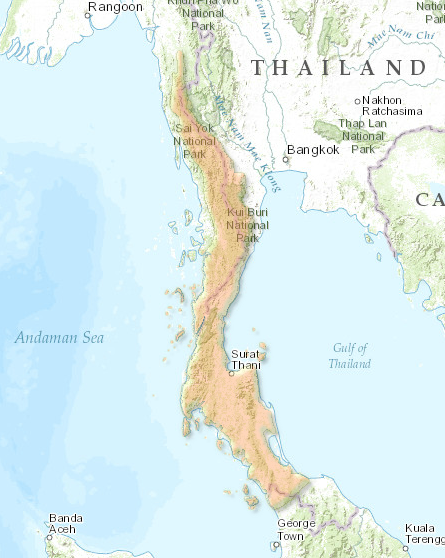Blogs posted from this ecoregion:
The ecoregion includes the montane forests of the Tenasserim Range, highlands separating Myanmar and Thailand, and extends south into the northern half of the Malay Peninsula. It covers most of the extreme southern finger of Myanmar (Tanintharyi Region), immediately adjacent parts of Thailand to the east, most of the Thai portion of the Malay Peninsula (including Phuket) and even a tiny sliver of extreme northern Malaysia. This ecoregion also includes the extensive lowland plains forests between the peninsular mountains, now mostly deforested.
Nearby ecoregions: i) the thin coastal strip in Myanmar to the west of the northern part of the ecoregion is the Myanmar Coastal Rain Forests (IM0132); ii) to the northwest of the northernmost finger of this ecoregion, and abutting it just barely, entirely in Myanmar, is the Irawaddy Moist Deciduous Forests (IM0117); iii) similarly just barely abutting the northernmost extension, to the northeast in both Myanmar and Thailand, is the Kayah-Karen Moist Deciduous Forests (IM0119); iv) the Chao Phraya Lowland Moist Deciduous Forests (IM0108) occur to the east of the northern Thai part of the ecoregion; v) patches of mangroves along the western coastal part of the ecoregion in Thailand and in Malaysia are in the Myanmar Coastal Mangroves (IM1404); vi) similar mangroves along the eastern coast part, facing the Gulf of Thailand, are in the Indochina Mangroves (IM1402); and finally, vii) at the extreme south in both Thailand and Malaysia, the ecoregion transitions to the Peninsular Malaysian Rain Forests (IM0146).
Description of the Ecoregion
A detailed description of the ecoregion can be found at WWF’s site (the map above is a screen shot from that Wildfinder site).
WWF states that it covers: “the transition zone from continental dry evergreen forests common in the north to semi-evergreen rain forests to the south. As a consequence, this ecoregion contains some of the highest diversity of both bird and mammal species found in the Indo-Pacific region. The relatively intact hill and montane forests form some of the best remaining habitat essential to the survival of Asian elephants and tigers in the Indo-Pacific region. However, the lowland forests are heavily degraded, and many lowland specialists such as the endemic Gurney’s pitta survive in a few isolated reserves”.
The lowland and montane forests are dipterocarp forests. Karst limestone towers are evident in many locations throughout peninsular Thailand, including islands off Thailand’s southwest coast.
Birds of the Ecoregion
WWF indicates that: “The diverse habitats within this ecoregion, from deciduous forests in the north to seasonal evergreen forests in the south, lowland to montane, make it one of the richest in bird species for the entire Indo-Pacific. A total of 560 bird species have been recorded here. However, with rapid habitat loss in the lowlands, many of these forest birds are threatened. One of the most critically endangered, Gurney’s pitta (Pitta gurneyi), is endemic to this ecoregion (table 2). This species, once thought to be extinct, survives in a few locations in lowland forest in the central part of peninsular Thailand. More than twenty-five pairs have been found in some of the last remaining forest, and that forest is now contained within Bang Kram wildlife sanctuary (Stewart-Cox 1995). [More recently, a healthier population of several thousand has been found in the Myanmar portion of the ecoregion]. The Malayan peacock-pheasant (Polyplectron malacense) is endemic to the hill and montane forests of this ecoregion (table 2). The lowland, alluvial, and wetland forests also support a wide variety of waterfowl. Species range from the large and colorful purple swamphen (Porphyrio porphyrio) to several majestic egret species (Stewart-Cox 1995). The lowland, hill, and montane dipterocarp forests are home to several species of the vivacious hornbills. Hornbills prefer to nest in tall trees (usually dipterocarps) in primary forests. At least nine hornbill species are found in these forests and include the nearly extinct wrinkled hornbill (Aceros corrugatus).
Table 2. Endemic and Near-Endemic Bird Species.
Family Common Name Species
Phasianidae Mountain peacock-pheasant Polyplectron inopinatum
Phasianidae Malayan peacock-pheasant* Polyplectron malacense*
Pittidae Gurney’s pitta* Pitta gurneyi*
Pycnonotidae Spectacled bulbul Pycnonotus erythropthalmos
An asterisk signifies that the species’ range is limited to this ecoregion.”
Resources for the Ecoregion Birder
I am not aware of any bird-related publications that focus specifically on this ecoregion. The best resources available would be those that cover more generally the countries that form the ecoregion.
